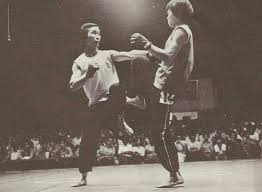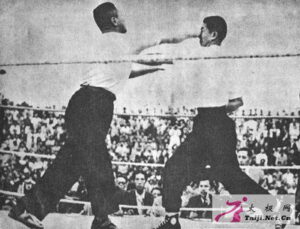Introduction
Sanda, also known as Sanshou, is a Chinese martial art that combines elements of traditional Chinese martial arts with modern combat techniques. It is a full-contact sport that includes striking, grappling, and wrestling techniques. The terms “Sanda” and “Sanshou” are often used interchangeably, with “Sanda” translating to “free fighting” and “Sanshou” to “free hand.” This essay explores the origins, development, and significance of Sanda and Sanshou in the martial arts world.
Origins and Early Development
The roots of Sanda and Sanshou can be traced back to ancient China, where martial arts were developed for self-defence, military training, and physical fitness. Traditional Chinese martial arts, such as Kung Fu, Tai Chi, and Wing Chun, have influenced the techniques and principles of Sanda. The concept of “Sanshou” (scatter hands) is much older than “Sanda” and was used to describe unstructured fighting techniques.

Lei Tai
Sanda can also be traced back to ‘Leitai’ challenge fight carried out in China & Hong Kong island.
Lei tai fights are a traditional form of Chinese martial arts competition that take place on an elevated platform known as a “lei tai.” These platforms are typically open-sided and can vary in height and size, but they are generally around 2 to 4 feet high and 24 x 24 feet in dimension.
Historical Background
The concept of the lei tai dates back to ancient China, with its origins possibly tracing back to the Qin dynasty. However, it became more formalised during the Song dynasty (960-1279 AD). Lei tai fights were no-holds-barred contests that combined various martial arts techniques, including striking, grappling, and wrestling. These matches could be bare-knuckle or involve the use of deadly weapons, and they often had no rules, making them extremely dangerous.
Rules and Structure of Lei Tai
In traditional lei tai fights, participants would lose if they surrendered, were incapacitated, or were thrown off the platform. The winner would remain on the stage as its “owner” until defeated by a stronger opponent. If no challengers remained, the fighter would be declared the champion. These matches were sometimes presided over by a referee and judges, but private duels could be fought to the death.
Modern Adaptations of Lei Tai
Today, the lei tai is used in modern Sanshou and Kuoshu competitions around the world. These contemporary matches are more regulated, with safety measures such as protective gear and standardised rules to ensure the well-being of the participants. Despite these changes, the essence of the lei tai as a platform for testing martial prowess remains intact.
Significance of Lei Tai
Lei tai fights hold a significant place in the history of Chinese martial arts. They represent the practical application of martial skills in a competitive environment and have influenced the development of modern combat sports like Sanda. The lei tai continues to be a symbol of martial excellence and tradition in Chinese culture.
Modern Development
In the early 20th century, the Chinese Nationalist government established the Whampoa Military Academy in 1924, where Sanshou was developed as a combat sport combining traditional Chinese martial arts with modern training methods. This initiative aimed to create a practical and effective fighting system for military personnel.
The modern form of Sanda emerged in the 1980s when the Chinese government sought to develop a competitive combat sport that showcased the practical self-defence techniques of traditional Chinese martial arts. Sanda was designed to be a full-contact sport that included striking, takedowns, throws, and grappling techniques. It was influenced by various martial arts styles, including Western boxing, Muay Thai, and Judo.

Sanda competitions are typically held in a ring, and fighters wear protective gear such as gloves, shin guards, and headgear. The rules of Sanda emphasise safety while allowing a wide range of techniques, including punches, kicks, knees, and elbows. Fighters can also score points through takedowns and throws.
Significance and Global Influence
Sanda has gained popularity both in China and internationally as a competitive sport and a practical self-defence system. It is practiced in martial arts schools and gyms worldwide, and international competitions are held regularly. Sanda’s emphasis on practical techniques and full-contact sparring has made it a respected discipline in the martial arts community.
In addition to its competitive aspect, Sanda is also used for self-defence and fitness training. Its comprehensive approach to striking and grappling makes it a versatile martial art suitable for various applications.
Conclusion
Sanda and Sanshou represent the evolution of traditional Chinese martial arts into a modern, competitive combat sport. With roots in ancient martial arts and development influenced by military training, Sanda has become a respected discipline known for its practical techniques and full-contact nature. As it continues to grow in popularity, Sanda remains a testament to the enduring legacy of Chinese martial arts and their adaptability to contemporary combat sports. The History of Sanda and Sanshou
